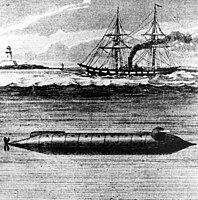Alligator (submarine)
|
The alligator submarine
|
||||||||||||||
|
||||||||||||||
|
||||||||||||||
|
||||||||||||||
|
||||||||||||||
|
||||||||||||||
|
||||||||||||||
Alligator was the first submarine in the Northern States . However, the submarine was never used.
prehistory
The French inventor and submarine pioneer Brutus de Villeroi emigrated to the United States in 1856 . In his new hometown of Philadelphia , he built a submarine in 1859 to salvage the ship HMS Braak , which was sunk off Lewes in 1798 and allegedly carried treasure. This submarine had a length of 9.14 m, a width of 1.83 m and a height of 2.44 m. When de Villeroi made a first sea trial on the Delaware River in May 1861 , his half-submerged submarine was reported to the authorities. The police arrested de Villeroi and confiscated the boat. Navy experts inspected the submarine and wrote a report on July 7th.
Construction and use
On November 1, 1861, a contract was signed with Brutus de Villeroi to build a submarine. Since the ship was urgently needed during the Civil War , an acceptance inspection and payment of $ 14,000 were agreed, provided that it would be completed within 40 days. On December 7th, Commodore Joseph Smith was informed that the steel outer shell with glass windows was finished, but that materials were still missing for the interior. The completion took until April 18, 1862. On May 1, the submarine was taken over by the Navy and towed to the naval base.
It was 14.33 m, 1.42 m wide and 2.49 m high and had a viewing dome with four windows. The submarine even had an air purification system. It was propelled by 8 rowers and reached a speed of two knots . Other crew members were the captain, the helmsman and one or two divers. The divers were able to attach mines to enemy ships via an air lock, which could be remotely ignited with the help of a battery system. Because of its green color, it was named alligator .
The first captain of the submarine was the civilian Samuel Eakin. The alligator was towed to Hampton Roads by the tug Fred Copp . As a first step, Eakin was supposed to blast obstacles in the James River at Drewry's Bluff in preparation for the First Stand . Eakin pointed out, however, that the water depth was insufficient for a diver to leave the ship through the lock when submerged.
The alligator was eventually towed to the Washington Navy Yard . Lieutenant Thomas O. Selfridge took command here in July and completed training and test programs. In the winter of 1862 the drive system was changed. The submarine received a propeller that was driven by hand cranks and now reached a speed of 4 knots.
An attack on Charleston was planned in March . The Alligator was supposed to sink the two ironclad ships CSS Chicora and CSS Palmetto State . On March 31, the steamship Sumter towed the submarine from Washington to Charleston. On the way about 80 km south of Cape Hatteras they got into a heavy storm on April 2nd. The rope to which the submarine was attached caused damage to the Sumter . In order not to capsize, the rope was cut. The alligator sank and has since disappeared.
Search for the wreck
A first search was carried out from August 23 to 29, 2004, which remained fruitless. The second expedition off Cape Hatteras from September 6 to 10, 2005 was also unsuccessful.
literature
- Submarines. The history of the submarines. Garant Verlag, Renningen 2017, ISBN 978-3-7359-1338-8 , p. 14.
Web links
- National Marine Sanctuaries: Hunt for the Alligator
- NavSource Online: Submarine Photo Archive: Alligator
